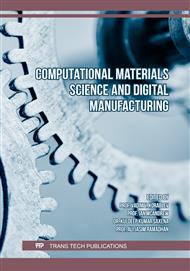p.77
p.83
p.89
p.99
p.109
p.117
p.135
p.151
p.163
Simulation Modeling as a Tool for Taking into Account the Influence of Production Factors on the Physical and Mechanical Characteristics of Parts in the Manufacture of Parts from Composite Materials with Vacuum Infusion
Abstract:
In modern conditions of expanding the use of intelligent manufacturing technologies and increasing requirements for the physical and mechanical characteristics of parts, modeling and assessment of the physical and mechanical characteristics of parts should begin with obtaining correct initial data on the structure of the parts material, taking into account its technological history. However, for some of production technologies, in present time, it’s quite problematic to obtain correct data to take into account a huge number of factors. For example, in the manufacture of thin-walled, low-rigidity parts from polymer composite materials (PCM) using the technology of autoclave vacuum infusion molding with after-heating, the influence of external factors is very huge. This is most noticeable in the manufacture of large low-rigidity parts, for which after-heating is possible only outside the autoclave, or, sometimes, only without removing the part from the mold equipment.
Info:
Periodical:
Pages:
109-114
Citation:
Online since:
April 2023
Price:
Сopyright:
© 2023 Trans Tech Publications Ltd. All Rights Reserved
Share:
Citation:


